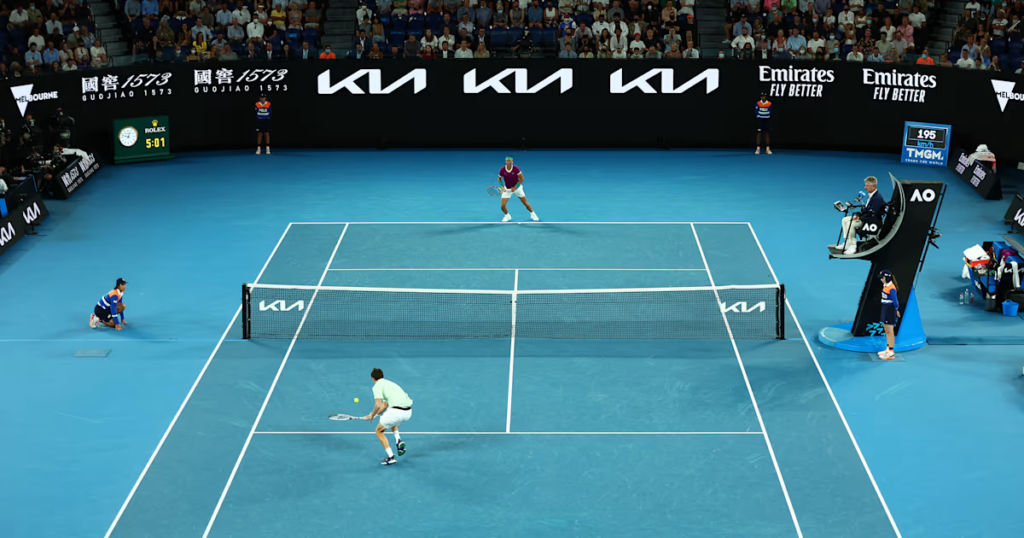Tennis is a racquet sport that allows for individual play against a single opponent (singles) or between two teams, each comprising two players (doubles). The game originated in England during the late 19th century and has since become one of the most popular sports worldwide. As the sport continues to gain popularity, many fans bet tennis online, enhancing their enjoyment of the game.
Getting Started with the Essentials: Understanding the Court
Before diving into the specifics of playing tennis, it’s essential to understand the layout of the tennis court. A standard tennis court is rectangular in shape, with a net running across the middle. The court is divided into two equal halves by the net, creating two service boxes on each side.
The Scoring System
Tennis uses a unique scoring system that may seem confusing to beginners at first but becomes second nature with practice. The scoring system consists of four points: 15, 30, 40, and game. To win a game, a player must earn at least four points and have a two-point lead over their opponent.
Basic Rules of Tennis
Tennis follows a set of rules designed to ensure fair play and sportsmanship. Some basic rules include:
- The tennis ball needs to be struck over the net and into the adversary’s court.
- Players must alternate hitting the ball, starting with a serve.
- The ball is allowed to bounce once on each side of the court before being returned.
Mastering the Grip and Stance: Grip Techniques
The grip is the foundation of every tennis shot, determining the angle and power of the racket face. There are several grip techniques used in tennis, including:
- Eastern Grip: Ideal for forehand shots.
- Continental Grip: Commonly used for serving and volleys.
- Western Grip: Suitable for generating topspin on groundstrokes.
Proper Stance
Maintaining a balanced and athletic stance is crucial for executing shots with precision and power. A proper stance involves:
- Keeping feet shoulder-width apart.
- Bending knees slightly to lower the center of gravity.
- Positioning body sideways to the net for forehand and backhand shots.
Developing Your Stroke Technique: Forehand Stroke
The forehand stroke is one of the most fundamental shots in tennis, executed by swinging the racket across the body in the direction of the ball. Key elements of a proper forehand stroke include:
- Racket preparation: Holding the racket back early to generate power.
- Swing path: Following through the shot in a smooth and controlled motion.
- Contact point: Striking the ball in front of the body to maximize power and accuracy.
Backhand Stroke
The backhand stroke is executed by swinging the racket across the body in the opposite direction of the ball. While there are variations of the backhand stroke, the two most common techniques are:
- One-handed backhand: Gripping the racket with one hand and using a single arm to swing.
- Two-handed backhand: Gripping the racket with both hands for added stability and power.
Serving Technique
The serve is the only shot in tennis that is entirely within the player’s control, making it a crucial aspect of the game. A proper serving technique involves:

- Starting in the correct position behind the baseline.
- Tossing the ball consistently to achieve the desired contact point.
- Using the entire body to generate power and spin on the serve.
Mastering Court Positioning and Movement: Understanding Court Zones
The tennis court is divided into several zones, each requiring different positioning and movement strategies. Understanding these zones is essential for maximizing defensive and offensive opportunities:
- Baseline: The area at the back of the court where players typically start each point.
- Service Box: The area where the ball must land during a serve.
- Net: The barrier that divides the court in half, requiring players to hit the ball over it.
Moving Strategically
Effective court movement involves anticipating your opponent’s shots and adjusting your positioning accordingly. Key strategies for moving strategically on the court include:
- Split-step: Performing a small hop just before your opponent makes contact with the ball to react quickly to their shot.
- Taking efficient steps: Moving in small, quick steps to maintain balance and agility.
- Anticipating shot direction: Reading your opponent’s body language and racket position to predict where the ball will go.
Developing a Winning Mindset: Mental Toughness
Tennis is as much a mental game as it is physical, requiring players to stay focused and resilient in the face of challenges. Developing mental toughness involves:
- Staying composed under pressure.
- Maintaining a positive attitude, regardless of the score.
- Learning from mistakes and moving on quickly.
Goal Setting and Progress Tracking
Setting specific, achievable goals is essential for tracking progress and staying motivated in tennis.

Whether it’s improving a specific stroke or winning a certain number of games, having clear objectives can help focus your practice sessions and measure your improvement over time.
Conclusion
You’ve completed the beginner’s guide to mastering the basics of tennis. By understanding the court layout, mastering grip, and stance techniques, developing stroke proficiency, mastering court positioning and movement, cultivating a winning mindset, and setting achievable goals, you’re well on your way to becoming a skilled tennis player. So grab your racket, hit the court, and start enjoying the exhilarating sport of tennis today!



